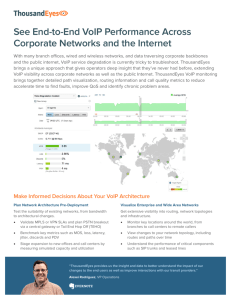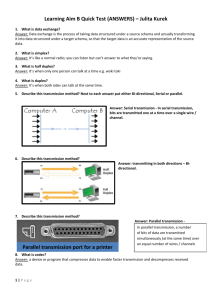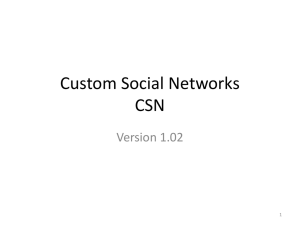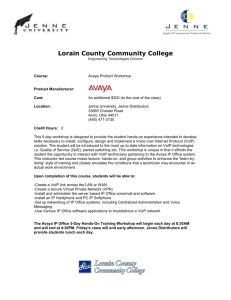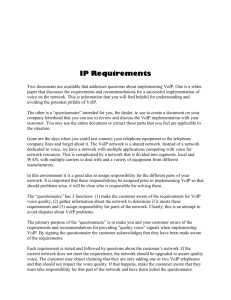Perspectives from FSF Scholars April 3, 2013 Vol. 8, No. 9
advertisement
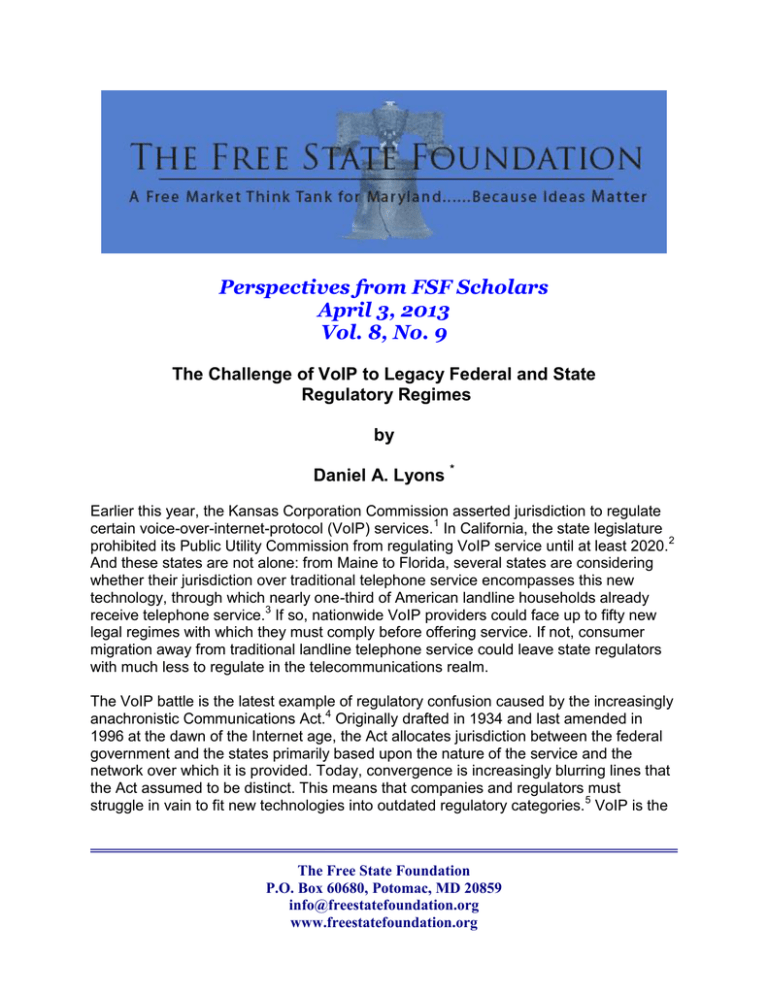
Perspectives from FSF Scholars April 3, 2013 Vol. 8, No. 9 The Challenge of VoIP to Legacy Federal and State Regulatory Regimes by Daniel A. Lyons * Earlier this year, the Kansas Corporation Commission asserted jurisdiction to regulate certain voice-over-internet-protocol (VoIP) services.1 In California, the state legislature prohibited its Public Utility Commission from regulating VoIP service until at least 2020.2 And these states are not alone: from Maine to Florida, several states are considering whether their jurisdiction over traditional telephone service encompasses this new technology, through which nearly one-third of American landline households already receive telephone service.3 If so, nationwide VoIP providers could face up to fifty new legal regimes with which they must comply before offering service. If not, consumer migration away from traditional landline telephone service could leave state regulators with much less to regulate in the telecommunications realm. The VoIP battle is the latest example of regulatory confusion caused by the increasingly anachronistic Communications Act.4 Originally drafted in 1934 and last amended in 1996 at the dawn of the Internet age, the Act allocates jurisdiction between the federal government and the states primarily based upon the nature of the service and the network over which it is provided. Today, convergence is increasingly blurring lines that the Act assumed to be distinct. This means that companies and regulators must struggle in vain to fit new technologies into outdated regulatory categories.5 VoIP is the The Free State Foundation P.O. Box 60680, Potomac, MD 20859 info@freestatefoundation.org www.freestatefoundation.org latest in a long series of policy challenges that illustrate the need for a new Act that better reflects an increasingly diverse and competitive telecommunications landscape. The Challenge of VoIP VoIP service illustrates the seemingly simple, yet deceptively complex, regulatory challenge posed by convergence. Traditional telephone service constitutes “telecommunications service” under Title II of the Act, which grants the Federal Communications Commission jurisdiction over interstate service but leaves intrastate communications to the states.6 By comparison, most Internet-based applications are classified as Title I “information services,” which the Act defines as “a capability for generating, acquiring, storing, transforming, processing, retrieving, utilizing, or making available information via telecommunications.”7 The Commission has generally deregulated information services, meaning states cannot regulate them.8 VoIP mimics traditional telephone service in functionality, but transmits over the Internet rather than the public switched telephone network. Which raises the question: can states regulate a Title II service carried over a Title I network? For nearly a decade, the Commission has provided little guidance regarding this question. In 2004, it ruled that Pulver.com’s Free World Dialup, a service that facilitated voice communication between computer users over the Internet, was an information service, in part because the company did not provide transmission and did not charge for its services.9 The Commission explained that traditional telephone rules do not necessarily apply to all voice services and that “state-by-state regulation of a wholly Internet-based service is inconsistent with the controlling federal role over interstate commerce required by the Constitution.”10 But later that year, the Commission ruled that AT&T’s use of the Internet, rather than traditional long-distance lines, to route calls between two traditional long-distance telephone customers did not exempt those calls from Title II regulation.11 Just as voice service was not a talisman invoking Title II, the use of the Internet did not automatically place a service comfortably within Title I. Since 2004, the Commission has explicitly refrained from classifying VoIP service under the Act, although it has increasingly imposed Title II duties on so-called “interconnected VoIP” providers. The Commission defines “interconnected VoIP” as services that enable real-time, two-way voice communications using a broadband connection and Internetprotocol-compatible customer premises equipment, but that allow users to receive calls from, and terminate calls to, the traditional public-switched telephone network.12 Like traditional telephone companies, interconnected VoIP providers must contribute to the Universal Service Fund, provide access to emergency 911 service, cooperate with law enforcement investigations, provide accommodations for disabled customers, and report outages to the Commission.13 In each order, the Commission has explained that it has authority to impose these duties on VoIP providers under either Title I or Title II. Several states stepped into the power vacuum created by the Commission’s conscious silence. This is unsurprising: telecommunications regulation often exhibits the “hydraulic pressure inherent” in government to “exceed the outer limits of its power.” 14 When the 2 Commission pursued a similarly ambiguous policy toward cable broadband service in the late 1990s, local regulators seized the initiative to declare it “cable service” under Title VI, thus subject to taxation and regulation at the state and local levels. 15 As several cases wound through the court system, this pressure from local franchise authorities forced the Commission to declare unambiguously that Internet access over cable lines fell under Title I and was therefore not subject to local franchising regulations.16 VoIP regulation has exhibited a similar pattern. Minnesota’s Public Utility Commission asserted jurisdiction over Vonage, an interconnected VoIP provider, finding it was providing “telephone service” and requiring it to comply with state tariff requirements and other telephone regulations. The Commission preempted Minnesota’s decision, but without classifying VoIP as a Title I or Title II service. 17 The Commission explained that if VoIP was a Title I service, Minnesota’s order would conflict with its national policy of nonregulation of information services. And even if it falls under Title II, as Minnesota claimed, state regulation would be preempted under the “impossibility” exception.18 This exception treats a service as interstate if the agency cannot separate its interstate and intrastate components. The Commission explained that although Vonage customers used normal telephone numbers, it was impossible to determine the geographic location of a Vonage user because a user could place a call from a computer anywhere in the country. Because it is impossible to determine with certainty the geographic origination of a Vonage call, it is impossible to determine whether the call is intrastate or interstate – which means under the Act it should be treated as interstate communications beyond the reach of state regulators. Shortly thereafter, several states identified a gap in the Vonage decision. While the impossibility exception applied to “nomadic” VoIP services such as Vonage, where the user could originate a call from a computer anywhere in the world, the same logic did not apply to “fixed” VoIP service. Like nomadic VoIP, fixed VoIP service delivers calls primarily over the Internet. But unlike nomadic VoIP, fixed VoIP uses a normal telephone that plugs into a wall jack. To the end user, therefore, fixed VoIP looks like traditional telephone service; the only difference is the way the call is delivered. More importantly, because the telephone is fixed, the caller’s geographic location is easy to identify. This means that, unlike Vonage, a fixed VoIP call can typically be classified as interstate or intrastate. Although the difference between nomadic and fixed VoIP service seems like hairsplitting, it is potentially significant to the future of state telephone regulators. Fixed VoIP providers are quickly gaining share of the telephone market. In 2009, Comcast’s Digital Voice Service, a VoIP product that uses dedicated Comcast lines rather than the public Internet to transmit calls, became the country’s third-largest telephone provider.19 Even traditional telephone companies such as Verizon have begun converting customers to VoIP services. The question whether the Communications Act distinguishes between nomadic and fixed VoIP service likely will thus dictate the extent to which state regulators remain more or less relevant as the industry evolves. 3 The Future of VoIP The states’ ongoing struggle illustrates the regulatory uncertainty fostered by the Act. Kansas is only one of many states that have expended scarce time and resources to divine the Commission’s true view on VoIP service, with no ultimate certainty that their efforts to preserve their jurisdiction will be successful. That uncertainty also affects the industry. Although VoIP is gaining market share, regulatory uncertainty leads companies to under-invest in VoIP technology, because the costs of regulatory compliance are unclear and therefore the potential benefit must be discounted by the risk of unexpected future compliance costs. AT&T has explained that the states’ ongoing efforts to regulate VoIP service have retarded the transition to an all-IP network of the future by retarding investment in IP technologies.20 For this reason, Verizon and others have lobbied states (with some success) to preemptively deregulate VoIP service. Both the states’ ongoing efforts and the industry’s lobbying represent substantial transaction costs attributable primarily to the ongoing ambiguity of the Commission's position. In the short run, the Commission should end this battle by classifying all VoIP as a Title I information service. It is simply bad policy to subject two services that consumers view as substitutes to two different regulatory regimes. The disparity handicaps the more regulated service, steering investors and consumers toward the less regulated alternative even if it is not in fact the most efficient solution in the market. Regulatory disparity also creates opportunities for companies to engage in regulatory arbitrage, steering company policies in a manner dictated not by market signals, but by the unintended consequences of regulations. Title I classification will also help the Commission develop a single, unified, coherent regulatory scheme consistent with a national service. State regulation of intrastate telephone service is an anachronism, an artifact from an era when customers distinguished between local and long-distance service, and when state services were dominated by local monopolies that required regulatory oversight. Since wireless companies began offering bundled local and long-distance service, this distinction has grown increasingly irrelevant. Today, customers overwhelmingly demand, and receive, nationwide calling service from a single provider and do not distinguish between intrastate and interstate calls. The market for voice service is increasingly competitive, pitting fixed and nomadic VoIP providers against the incumbent telephone company and several wireless providers. If states are permitted to regulate these new emerging services like they did the old telephone monopoly, it could create barriers to entry that can hinder the growth of this new technology and retard the benefits of competition in voice service. The Future of State Telecommunications Regulation More fundamentally, the VoIP battle shows the need to re-think the Communications Act’s approach to telecommunications regulation. Companies simply do not offer monoline telecommunications services over single-purpose networks anymore, and the 4 law should reflect this reality. Even AT&T, the original telephone monopoly, admits that “with each passing day, more and more communications services migrate to broadband and IP-based services, leaving the public switched telephone network and plain old telephone service as relics of a by-gone era.”21 Vonage and other VoIP providers are hastening this transition in the traditional telephone space. Hulu and Netflix are harbingers of a similar transition in video service. Going forward, voice and video will be simply two of many applications that ride on top of the Internet, which consumers may reach through several different platforms. Notably, each of these services is primarily national in scope, meaning that regulatory oversight should be concentrated largely at the national level. Of course, the decision to preempt state regulation should not be taken lightly. Decentralization of authority and institutional respect for state sovereignty are hallmarks of “Our Federalism” and serve important values, including policy experimentation, responsiveness to local concerns, and accountability by public figures who are close to those whom they govern.22 But fragmented, decentralized authority poses problems when attempting to regulate activities that are national in scope. State regulators may impose requirements that benefit their constituents but that negatively affect out-of-state residents by disrupting national economies of scale. Professor and former Judge Michael McConnell, an ardent defender of federalism, notes that “[e]xternalities present the principal countervailing consideration in favor of centralized government.”23 In the next Communications Act, Congress should allocate jurisdiction over the network between the federal government and the states in a platform-neutral manner, and with an eye toward the unique strengths of each level of government. States should retain some regulatory authority over issues such as rights-of-way management, undergrounding, and tower siting, which depend on local knowledge that federal regulators lack the ability and inclination to adjudicate properly. But they should not be entrusted with decisions that affect rates, market entry, or universal service. State-bystate regulation of these issues would create substantial spillover effects that could disrupt national economies of scale. And on consumer protection issues, states should be advocates at the federal level for policies that benefit their constituencies. But final decisionmaking authority should vest primarily in the federal government, which has a national mandate and can assess the nationwide costs and benefits of a particular proposal. This unified framework would better fit the telecommunications architecture of the next century and would avoid the uncertainty and distortion inherent in the existing silo-based model. * Daniel A. Lyons, an Assistant Professor of Law at Boston College Law School, is a member of the Free State Foundation's Board of Academic Advisors. The Free State Foundation is a non-profit, nonpartisan, free market-oriented think tank located in Rockville, Maryland. 5 1 See In re General Investigation of TWC Digital Phone LLC to Show Cause Why This Commission Should Not Impose Sanctions, Fines, or Penalties for the Company's Failure to Obtain a Certificate of Convenience and Authority and Have an Approved Tariff on File with the Commission, Docket No. 13-TWCZ-405-SHO (Jan. 30, 3013), available at http://estar.kcc.ks.gov/estar/ViewFile.aspx/20130130142939.pdf?Id=c447c27d-d864-4307-a8316b7d3aa05917. 2 SB No. 1161, signed by Governor Jerry Brown on Sept. 28, 1012, available at http://leginfo.legislature.ca.gov/faces/billNavClient.xhtml?bill_id=201120120SB1161&search_keywords. 3 FCC Extends Outage Reporting Requirements to VoIP Providers, TR DAILY, Feb. 15, 2012. 4 47 U.S.C. § 151 et seq. 5 See Daniel A. Lyons, Technology Convergence and Federalism: Who Should Decide the Future of Telecommunications Regulation? 43 U. MICH. J.L. REFORM 383 (2010). 6 47 U.S.C. § 152. 7 47 U.S.C. § 153(20). 8 See, e.g., In re Vonage Holdings Corp., 199 FCC Rcd. 22404, 22416-17 (2004) (describing Commission’s longstanding policy of preempting information services regulations). 9 Petition for Declaratory Ruling that Pulver.com’s Free World Dialup is Neither Telecommunications nor a Telecommunications Service, 19 FCC Rcd. 3307 (2004). 10 Id. at 3317. 11 In re Petition for Declaratory Ruling that AT&T’s Phone-to-Phone IP Telephony Services are Exempt from Access Charges, 19 FCC Rcd. 7457 (2004). 12 47 C.F.R. § 9.3. The Pulver Order seemed to indicate that non-interconnected, Internet-only VoIP services are preempted information services. See, e.g., Caller Identification Information in Successor or Replacement Technologies, Report to Congress, 26 FCC Rcd. 8643, 8655 (2011) (“An important category is Internet-only noninterconnected VoIP service that enables users to engage in two-way voice conversations over the publiclyaccessible Internet without interconnecting to the PSTN. In at least one instance, the Commission has declared such a service to be an information service and thus not subject to the Commission's rules governing CPN services.”) (citing Pulver Order). 13 See, e.g., In re Connect America Fund, 26 FCC Rcd. 4554, 4582 (Feb. 9, 2011) (“To date, the Commission has not classified interconnected VoIP service as either an information service or a telecommunications service. The Commission has, however, extended certain obligations to providers of such service, including local number portability, 911 emergency calling capability, universal service contribution, CPNI protection, disability access and TRS contribution requirements, and section 214 discontinuance obligations.”); see also Rob Frieden, From Bad to Worse: The Long-Term Consequences of Four Controversial FCC Decisions, 77 BROOK. L. REV. 959, 985 (2012). 14 INS v. Chadha, 462 U.S. 919, 951 (1983). 15 See, e.g., AT&T Corp. v. City of Portland, 216 F.3d 871, 875–76 (9th Cir. 2000) (striking down city’s attempt to impose open access requirement on cable modem operator); MediaOne Group, Inc. v. County of Henrico, 97 F. Supp. 2d 712, 715 (E.D. Va. 2000) (same); Bova v. Cox Communications, Inc., 2002 WL 389264 (W.D.Va. Mar. 12, 2002) (describing attempts to impose local franchise fees on cable Internet service); see Daniel A. Lyons, Technology Convergence and Federalism: Who Should Decide the Future of Telecommunications Regulation? 43 U. MICH. J.L. REFORM 383, 403 (2010). 16 In re Inquiry Concerning High-Speed Access to Internet over Cable and Other Facilities, 17 FCC Rcd. 4798; see National Cable & Telecomm. Ass’n v. Brand X Internet Servs., 545 U.S. 967 (2005). 17 Minn Pub. Util. Comm’n v. FCC, 483 F.3d 570, 575-76 (8th Cir. 2007). 18 47 U.S.C. § 152(b). 19 Press Release, Comcast Now the Third Largest Residential Phone Services Provider in the U.S., Mar. 11, 2009, available at http://www.comcast.com/About/PressRelease/PressReleaseDetail.ashx?PRID=844&SCRedirect=true. 20 See AT&T Petition to Launch a Proceeding Concerning TDM-to-IP Transition, Nov. 7, 2012, at 18. 21 International Comparison and Consumer Survey Requirements in the Broadband Data Improvement Act, GN Docket No. 09-47, 09-51, 09-137 (cmt. of AT&T Inc.), available at http://www.teledynamic.com/_uploads/AT&T%20Comments%20On%20Ending%20PSTN.pdf. 22 See Lyons, supra note 15, at 415. 23 Michael W. McConnell, Book Review, Federalism: Evaluating the Founders’ Design, 54 U. CHI. L. REV. 1484, 1495 (1987) (reviewing Raoul Berger, FEDERALISM: THE FOUNDERS’ DESIGN (1987)). 6


